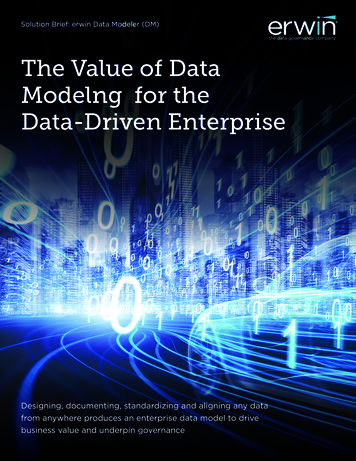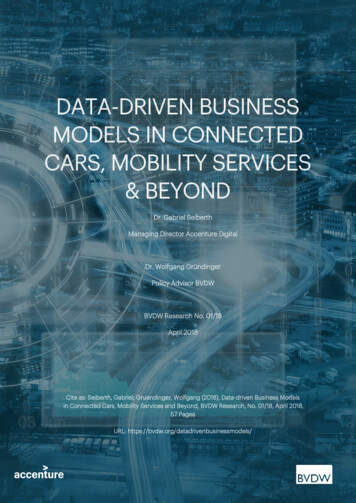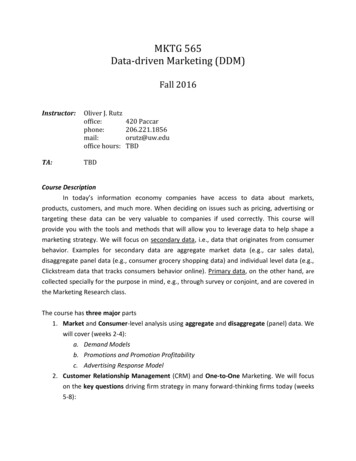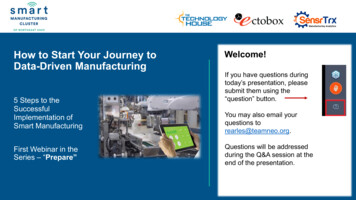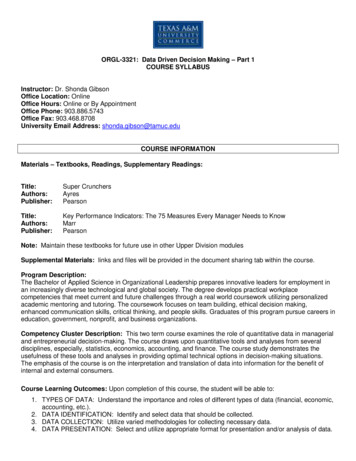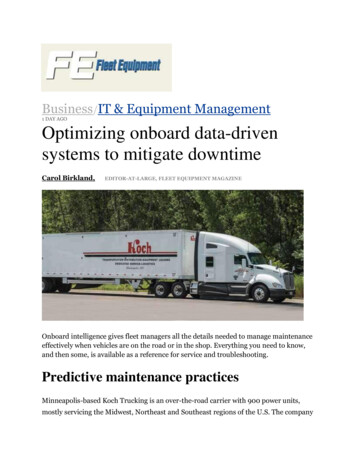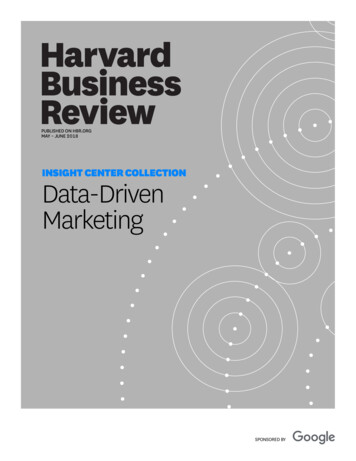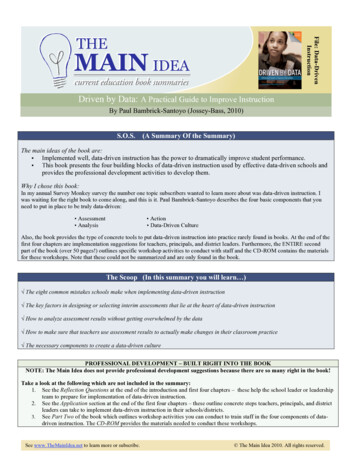
Transcription
File: Data-DrivenInstructionDriven by Data: A Practical Guide to Improve InstructionBy Paul Bambrick-Santoyo (Jossey-Bass, 2010)S.O.S.(A Summary Of the Summary)The main ideas of the book are: Implemented well, data-driven instruction has the power to dramatically improve student performance. This book presents the four building blocks of data-driven instruction used by effective data-driven schools andprovides the professional development activities to develop them.Why I chose this book:In my annual Survey Monkey survey the number one topic subscribers wanted to learn more about was data-driven instruction. Iwas waiting for the right book to come along, and this is it. Paul Bambrick-Santoyo describes the four basic components that youneed to put in place to be truly data-driven: Assessment Analysis Action Data-Driven CultureAlso, the book provides the type of concrete tools to put data-driven instruction into practice rarely found in books. At the end of thefirst four chapters are implementation suggestions for teachers, principals, and district leaders. Furthermore, the ENTIRE secondpart of the book (over 50 pages!) outlines specific workshop activities to conduct with staff and the CD-ROM contains the materialsfor these workshops. Note that these could not be summarized and are only found in the book.The Scoop (In this summary you will learn ) The eight common mistakes schools make when implementing data-driven instruction The key factors in designing or selecting interim assessments that lie at the heart of data-driven instruction How to analyze assessment results without getting overwhelmed by the data How to make sure that teachers use assessment results to actually make changes in their classroom practice The necessary components to create a data-driven culturePROFESSIONAL DEVELOPMENT – BUILT RIGHT INTO THE BOOKNOTE: The Main Idea does not provide professional development suggestions because there are so many right in the book!Take a look at the following which are not included in the summary:1. See the Reflection Questions at the end of the introduction and first four chapters – these help the school leader or leadershipteam to prepare for implementation of data-driven instruction.2. See the Application section at the end of the first four chapters – these outline concrete steps teachers, principals, and districtleaders can take to implement data-driven instruction in their schools/districts.3. See Part Two of the book which outlines workshop activities you can conduct to train staff in the four components of datadriven instruction. The CD-ROM provides the materials needed to conduct these workshops.See www.TheMainIdea.net to learn more or subscribe. The Main Idea 2010. All rights reserved.
Introduction – What Is Data-Driven Instruction All About?Education articles have captured numerous stories about schools that have improved their instruction based on “data-driven” practicesand achieved outstanding results within a few years. In fact, “data-driven instruction” has become one of the most discussed newtopics in education. However, at the same time, it is one of the most misunderstood topics. Some people believe data-driven schoolssimply conform to NCLB dictates. Others believe that these schools forgo authentic learning and instead merely “teach to the test.”Given this confusion, some leaders hope that they can bypass this data craze with the idea that “this too shall pass.”However, it would be a mistake for leaders to give up on data. When conducted properly, using data to inform teaching practice is oneof the most effective ways to help students achieve success. Data-driven instruction involves changing a school’s focus from “whatwas taught” to “what was learned.” This book outlines exactly how you create such a data-driven culture in order to achieve academicexcellence. The ideas presented in Driven by Data are not based on a theoretical model, but rather come from the practices of schoolsthat, using data-driven instruction, have achieved dramatic gains in student performance.There are many vignettes throughout the book describing how actual schools achieved impressive results using a data-drivenapproach. For example, at Fort Worthington Elementary School, a school in which 85 percent of the students receive free or reducedlunch and 98 percent are African American, the principal put the components of data-driven instruction in place and saw the followingtremendous gains. Note that these are more than numbers; these represent hundreds of additional students reaching proficiency.Subject2005-062006-072007-08Overall GainsGrade 349%55%88% 39English and Language ArtsGrade 4Grade 550%42%62%55%92%86% 42 44Grade 344%74%86% 42MathematicsGrade 443%71%88% 45Grade 544%74%86% 42So how exactly did these schools, and many others that used this approach, get such remarkable results? They were able to implementthe four fundamental building blocks of effective data-driven instruction. These four principles are:1. Assessment – Create rigorous interim assessments that provide meaningful data.2. Analysis -- Examine the results of assessments to identify the causes of both strengths and shortcomings.3. Action – Teach effectively what students most need to learn based on assessment results.4. Culture – Create an environment in which data-driven instruction can survive and thrive.If there are so few fundamental principles, why haven’t more schools succeeded? Most schools have assessments and do some kind ofanalysis, so shouldn’t they see dramatic results as well? The truth is, while all schools make mistakes, there are certain mistakes whenit comes to data-driven instruction that make it difficult to succeed. Below is a description of those mistakes.Eight Mistakes That Impede Successful Implementation of Data-Driven InstructionSchools that implement data-driven instruction effectively avoid the following common pitfalls:1. Inferior interim assessments -- Many schools fail to get results when they use interim assessments that set the bar too low, do notalign to other required tests, or neglect to include open-ended questions.2. Secretive interim assessments -- Interim assessments are only useful if teachers and schools see them before they teach. For theseassessments to drive rigor, teachers must know the end goals before they plan instruction.3. Infrequent assessments -- Some schools give these assessments only once every three to four months. This is not frequent enoughto provide the data needed to improve instruction.4. Curriculum-assessment disconnect -- A common mistake that occurs is when the curriculum does not match the content of theinterim assessment. These assessment results have nothing to do with what happened in the classroom.5. Delayed results -- Interim assessments are useless unless they are graded and analyzed promptly so teachers can make adjustments.6. Separation of teaching and analysis -- Another problem occurs when teachers hand over the data analysis to a data team. Teachersneed to analyze the results themselves in order to take ownership over the process.7. Ineffective follow-up -- One serious shortcoming is when there is only a vague commitment to make adjustments after analyzingthe results. If there is no specific plan for improvement that is scheduled to happen at a specific time, no real changes will be made.8. Not making time for data – Some schools fail to make time for assessments, data analysis, and follow-up. Schools are busy placesand if no time has been set aside in the calendar to make data-driven improvement a priority, it simply won’t happen.1 (Driven by Data, Jossey-Bass)hjjyffg.ne.net2009 The Main Idea 2010
Part I – The Four Building Blocks of Effective Data-Driven Instruction1. AssessmentThe Four Building Blocks of Effective Data-Driven Instruction2. Analysis3. Action4. CultureThe 1st Building Block – ASSESSMENTAssessment is the first of the four building blocks of data-driven instruction. Assessments are crucial in defining exactly whatinstruction should take place. Consider this example below:A principal intern brought a math teacher’s worksheet into Bambrick-Santoyo’s offce and asked, “What do you notice?”Bambrick-Santoyo responded, “This looks like a basic review of fractions.”“Exactly,” the intern responded, “But the interim assessment we just gave asks students to solve word problems withfractions, and in addition, those fractions are more complex.”There was clearly a disconnect between what the teacher was teaching and what was being assessed on the interim assessment. Theabove example shows one of the reasons assessments are so important – they help to clarify what students should be learning. Withoutan assessment, teachers are often left with vague standards like the following:Understand and use ratios, proportions and percents in a variety of situations.–New Jersey Core Curriculum Content Standards for Mathematics Grade 7, 4.1.A.3Different teachers could choose many different ways to teach this standard and would assess it in very different ways. Look at thevarying types of assessments you might see from different teachers:1. Identify 50% of 202. Identify 67% of 813. Shawn got 7 correct answers out of 10 questions on his science test. What percent did he get correct?4. In the NCAA, J.J. Redick and Chris Paul were competing for best free-throw shooting percentage. Redick made 94% of his first103 shots, while Paul made 47 out of 51 shots.a. Which one had a better shooting percentage?b. In the next game, Redick made only 2 out of 10 shots while Paul made 7 of 10. What are their new overall percentages?c. Who is the better shooter?While these all align to the state standard, they are quite different in scope, difficulty, and design. This shows that standards aremeaningless until you define how you will assess them. The types of questions students are expected to answer determines the level atwhich students would learn. This may seem counterintuitive, but instead of standards determining the type of assessments used, thetype of assessments used actually define the standard that will be reached. So what does this mean for schools that wish to implementdata-driven instruction? That they should create rigorous tests and then provide the type of instruction to meet those standards. Thischapter outlines the five crucial elements, or “drivers” of effective assessments:ASSESSMENT: Five Core Drivers1. Common and interim2. Transparent starting point3. Aligned to state tests and college readiness4. Aligned to instructional sequence5. Re-assessed previously taught standardsCore Driver 1: Assessments Must Be Common and InterimIn effective data-driven instruction the most important assessments are interim assessments: formal written tests taken every six toeight weeks. More than a traditional scope and sequence, interim assessments provide a roadmap to rigorous teaching and learning.Then carefully analyzing interim assessment results on a regular basis provides the feedback teachers need to improve their teachingrather than waiting for the results of a year-end test. Interim assessments hold teachers and principals accountable for student learningby accurately measuring student performance without the teacher support normally given in a classroom. Furthermore, rather thanhave individual teachers decide their own level of rigor, data-driven schools create rigorous interim assessments that are common to allgrade-level classes in each content area.Core Driver 2: Assessments Must Be The Starting Point and Must Be TransparentTraditionally, assessments are designed at the end of the quarter or semester and what is assessed is based on what is taught. Ineffective data-driven instruction this process must be reversed such that interim assessments are created before the teaching begins. Itis the rigor of the assessment that drives the rigor of what is taught. In addition, everyone – teachers, school leaders, parents,community members – should know what skill level students are expected to reach and the necessary steps to get there.2 (Driven by Data, Jossey-Bass)hjjyffg.ne.net2009 The Main Idea 2010
Core Drivers 3 and 4: Assessments Must Be AlignedAll public and many private schools must take high-stakes tests. At the primary level these might be state or district exams. At thesecondary level it could include SAT/ACT or AP/IB assessments. To help students succeed on these tests, interim assessments shouldbe aligned to those tests in format, content, and length. The interim assessments should also help prepare students for college andtherefore be aligned to college readiness standards as measured by SAT/AP/IB exams, research papers, and other measures. Of coursethe assessments should also be aligned to the school’s clearly defined grade level and content expectations so teachers are teachingwhat will be assessed.Core Driver 5: Assessments Must Re-Assess Previously Taught StandardsIf interim assessments only assess what was taught during one period of time, they would serve more as unit-end tests than interimassessments. Including material that was previously taught helps ensure that students retain that material and also provides anopportunity for teachers to see if their re-teaching efforts were successful. This is a common mistake that schools make – they fail toreview past material.WRITING OR SELECTING THE RIGHT INTERIM ASSESSMENTSome schools that effectively implement data-driven instruction create their own interim assessments while others select from thosealready available. Either process can lead to success as long as one applies the following core principles:Core Principles in Writing/Selecting Effective Interim Assessments* Start from the end-goal exam – When designing or selecting interim assessments, make sure it is based on the exams studentsmust take at the end of the year (state, district, SAT, etc.) and not the vague standards discussed earlier.* Align the interim assessments t
The main ideas of the book are: Implemented well, . Jossey-Bass) . If there is no specific plan for improvement that is scheduled to happen at a specific time, no real changes will be made. 8. Not making time for data – Some schools fail to make time for assessments, data analysis, and follow-up. Schools are busy places and if no time has been set aside in the calendar to make data .
